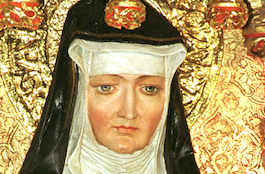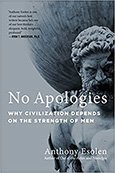Know the Ways
- ANTHONY ESOLEN
In our time, the saintly must prove itself to the political, which often stops up its ears. In the time of Saint Hildegard of Bingen (1098-1179) it was often the other way around: the political had to prove itself to the saintly.
Join the worldwide Magnificat family by subscribing now: Your prayer life will never be the same!
 St. Hildegard of Bingen
St. Hildegard of Bingen1089-1179
At the National Prayer Breakfast in Washington in 1994, a gentle old nun from Albania, Mother Teresa, dared to say that "the greatest destroyer of peace today is abortion," because by it we reject Jesus who said, If you receive a little child, you receive me. The audience, uneasy at first, broke into loud and sustained applause; a few sat in stony silence.
In our time, the saintly must prove itself to the political, which often stops up its ears. In the time of Saint Hildegard of Bingen (1098-1179) it was often the other way around: the political had to prove itself to the saintly. Hildegard, a holy woman, was a powerful voice in Europe, highly influential and highly regarded. She was called "The Sibyl of the Rhine," a woman of prophetic vision, much sought after for wisdom regarding matters earthly and heavenly. Had Mother Teresa lived when Hildegard did, she too would have been sought by priests and princes, bishops and kings. It takes real temerity, or blank ignorance, to turn away from words sent by God.
All the world in an egg
Out of the mouths of babes, says the Psalmist, the Lord has fashioned praise. So it was in the life of Hildegard. When she was only eight, her parents placed her in a Benedictine convent, though she was frail, and her eyes were so bad that she couldn't learn right away to read and write. But she saw things: she had visions. She never thought highly of herself for these gifts. In fact, she thought at first that everybody had them. They continued all her life long. Only when she was forty years old and abbess of the convent did the voice of God command her to put the visions in writing, and, after seeking counsel from her spiritual advisor, she did so, submitting them to the approval of her bishop. The pope himself, Eugenius III, encouraged her to continue. Notice the obedience. The work is called Sci Vias: Know the Ways.
Pope Benedict XVI said that Hildegard was a great exemplar of "the feminine genius," a rich soil, I would say, made up of humility and receptiveness, and the ability to see the holy in the smallest living things. God gave her to see the whole universe as an egg, held in place by three rays coming forth from a ball of fire. That was a sign of the Son of God coming to earth as a man, making known to us the things of heaven, and giving us cause to praise him, "incarnate of the true Maiden when the angel proclaimed him," and Mary, "alive in soul and body, received him in faith and joy."
People appealed to Hildegard, not for her to declare her opinion, but to ask her to pray that God might give her visions to help them find the truth.
The visions are far more intricate than I can describe. Hildegard herself drew illuminations of some of them, and they are like medieval rose windows — wheels within wheels, ranks within ranks, as with her extraordinary vision of the heavenly hierarchies of angels as nine concentric circles of faces, divided into sections of three, surrounding a central circle of pure white. Pope Benedict said that the visions are like those of the Old Testament prophets — think of Ezekiel and the valley of the dry bones. They are powerfully suggestive, founded in imagery that is rich in allusion to God's revelation, while also appealing to the universal experience of mankind.
Hope and life are green
Part of that experience that was close to Hildegard's heart was the goodness of the natural world. She was a collector of herbs, noting their various powers for healing and using them for the sisters in her abbey, so that some people say that she was the originator of natural science in Germany. Certainly she was fascinated with all things alive and green: greenness is ever on her mind when she thinks of the grace of God and the fertility of Mary's womb. Here is an antiphon she wrote for her sisters to sing for the office for virgins:
O noblest of all living green,
Who send your root into the sun,
And in a calmness full of light
Shine in a wheel beyond the bounds
Of any excellence of earth:
The rings of ministers divine
Enclose you in their bright embrace.
Like the first rose of dawn you blush,
Like the flame of the sun you burn.
Holy virgins above all, she seems to say, are green and fruitful. So in a letter to Saint Bernard of Clairvaux, she appeals to the Father who "through the sweet power of green vigor" sent the Word into the womb of Mary, where it became like "honey in the honeycomb." In another of her antiphons, she and her sisters beg the Lord to preserve them in their virginity, through the power of his love. Her language is bold indeed:
In the gift of your blood
We are wedded to you:
We who will know no man
Choose you, the Son of God.
Hammer of Heretics
Hildegard was all the bolder because she submitted her mind and heart to the Church, and so she was trusted when the heresies of the time lifted their dark heads. These both had to do with the created world, and the Church's relationship to it. The Cathari — the "pure" — were like the Manicheans in the time of Augustine, believing that the physical world was fundamentally bad. The most ardent among them sought salvation by starving themselves, while the less ardent engaged in sexual sins with an easy conscience, since things of the body were not ultimately important. The followers of Arnold of Brescia, meanwhile, were stoked to fury over the wealth and ease of many churchmen, and Arnold finally declared that it was wrong for the Church to own any property at all.
People appealed to Hildegard, not for her to declare her opinion, but to ask her to pray that God might give her visions to help them find the truth. Here she writes to Pope Eugenius, on the firebrand Arnold: "He who is not silent speaks," she begins, as the mouthpiece of God. There's a jewel on the path, and a bear sweeps it up in his paw to close it in his bosom, but suddenly an eagle swoops down and snatches the jewel from the bear, hiding it in his wings till he presents it to the king in his palace. Be like the eagle, she cries to Eugenius!
If Adam had never fallen, his voice, said Hildegard, which God had made to resound with the harmonies of every created thing, would have been too wonderful for our weak human nature to endure.
As for the Cathars, Hildegard herself left her abbey for the great city of Cologne, to correct them and their shameful deeds — which, she said in words that God revealed to her, are "most vile in my sight." The created order itself was at stake, and the good of marriage, which is the work of the indivisible God.
The music of the heavens
But I should like to conclude with something true and beautiful. Hildegard, who never had a formal education, is the medieval composer from whom we have the greatest number of works, for which she usually wrote both the texts and the music. The songs are sung in unison, as is the rule for Gregorian chant. But Hildegard set the melodies specifically for the words. If you know what the words mean, she seems to say, you will know why you are singing those notes and not others. Most especially you will let your heart be raised by the long and soaring melismas, plays upon a single syllable. The opening "O" of O nobilissima viriditas lingers over twenty-two notes; the second syllable of the word divinorum plays lovingly over fifty-nine notes. Imagine her convent of women, with their sweet female voices, raising her haunting strains of sound in praise of the eternal Bridegroom.
"You are taken up into heavenly places," said the scholar and abbot Odo of Soissons, who marked it as a sign of God's favor that though Hildegard had never studied music, she could compose so marvelously. She too thought of it as a gift and not as her own production. The title of her book of music says as much: Symphonia harmoniae caelestium revelationum, The Symphony of the Harmony of Heavenly Revelations. If Adam had never fallen, his voice, said Hildegard, which God had made to resound with the harmonies of every created thing, would have been too wonderful for our weak human nature to endure.
Saint Hildegard has become popular among some in our time, but for the wrong reasons, just as many people admired or pretended to admire Mother Teresa, while ignoring what she was all about. Hildegard made her music, I should say, because she listened. And that is what obedience is all about.
 This is Meaghen Gonzalez, Editor of CERC. I hope you appreciated this piece. We curate these articles especially for believers like you.
This is Meaghen Gonzalez, Editor of CERC. I hope you appreciated this piece. We curate these articles especially for believers like you.
Please show your appreciation by making a $3 donation. CERC is entirely reader supported.

Acknowledgement
 Anthony Esolen. "How the Church Has Changed the World: Know the Ways." Magnificat (September, 2021).
Anthony Esolen. "How the Church Has Changed the World: Know the Ways." Magnificat (September, 2021).
Join the worldwide Magnificat family by subscribing now: Your prayer life will never be the same!
To read Professor Esolen's work each month in Magnificat, along with daily Mass texts, other fine essays, art commentaries, meditations, and daily prayers inspired by the Liturgy of the Hours, visit www.magnificat.com to subscribe or to request a complimentary copy.
The Author

Anthony Esolen is writer-in-residence at Magdalen College of the Liberal Arts and serves on the Catholic Resource Education Center's advisory board. His newest book is "No Apologies: Why Civilization Depends on the Strength of Men." You can read his new Substack magazine at Word and Song, which in addition to free content will have podcasts and poetry readings for subscribers.
Copyright © 2021 Magnificat



